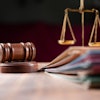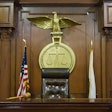
The coronavirus disease (COVID-19) pandemic changes the world every day and almost every hour. Whatever is written or reported now may not be relevant the following day.
No matter what changes, however, one thing is for sure: Our patients need a dentist when the symptoms point to pain, infection, and not being able to eat due to broken or ill-fitting appliances and other dental prosthetics.
 James Anderson, DMD.
James Anderson, DMD.When the ADA issued a ruling that nonessential treatment is not allowed due to the COVID-19 pandemic, we were caught not knowing what to do. Patients don't know what is nonessential. They have a concern, and they want someone to look at it and ease their fears. As dental providers, we know that many dental diseases and conditions don't have pain as a symptom in the beginning.
Wikipedia defines teledentistry as "the use of information technology and telecommunications for dental care, consultation, education, and public awareness." Teledentistry is getting serious attention because it is helping dental professionals connect to patients that are, for reasons other than the COVID-19 pandemic, unable to get to a dental office for an examination.
Teledentistry is making a difference by being able remotely to service underserved populations nationally (and even internationally) via a network of healthcare providers. It has applications in nursing homes, hospitals, and schools, too, when getting to a dental office is next to impossible.
Teledentistry can promote the integration of dentistry into the broader healthcare system to improve oral-systemic care. It can help change the concept that oral health is separate from overall health.
The ADA created two codes to be used for reimbursement when employing teledentistry. These codes went into effect in January 2018. It is certainly proof that teledentistry is part of the future of dentistry.
These codes are reported in addition to other diagnostic procedures delivered to the patient on the date of service. Because these codes are new, and the concept is just beginning to garner professional recognition, reimbursement may be unreliable at first. Continuing to use the coding correctly and, when applicable to the patient's care, will demonstrate to the insurance companies the need for payment on these services.
The teledentistry codes from the ADA are explained below:
- D9995 Teledentistry-synchronous; real-time encounter: The encounter is not like a routine phone consultation or a video conference call. It would include instances in which both consulting professionals "interact" with one another and the patient during the encounter.
- D9996 Teledentistry-asynchronous; information stored and forwarded to the dentist for subsequent review: The encounter is not a regular phone or video conference but an instance in which the following professional would have access to and could review the patient's information at a remote location after the initial encounter. The professional could then provide advice or treatment recommendations through technology such as video conferencing rather than any direct personal contact with the patient.
Billing the codes as intended is the key to reimbursement, and having a knowledgeable billing expert is a key to getting the claims paid.
Reimbursement for the codes will vary widely among commercial plans and government-funded plans. Under certain circumstances, some medical plans will consider payment of teledentistry under particular conditions. Reporting these conditions requires the right clinical encounter notes.
Just like many things in dentistry, each state is proceeding with teledentistry according to its own laws. Your state dental board is the best source of information on the legal and ethical considerations for using teledentistry in your area.
During these unsettling times of the SARS-CoV-2 coronavirus, it is crucial that we, as dental healthcare providers, provide the essential care necessary to our patients and communities.
James Anderson, DMD, is a practicing dentist in Syracuse, UT, and is the CEO and founder of eAssist Dental Solutions. He can be reached via email.
The comments and observations expressed herein do not necessarily reflect the opinions of DrBicuspid.com, nor should they be construed as an endorsement or admonishment of any particular idea, vendor, or organization.


















